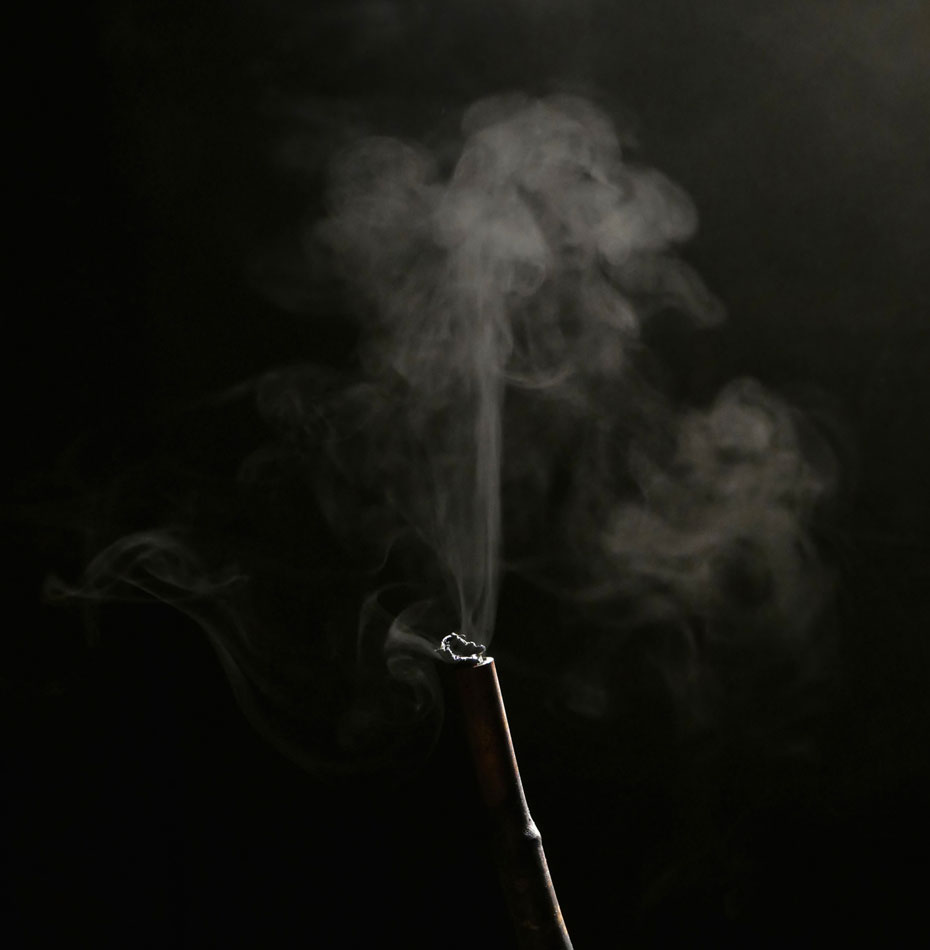Habiter, Château du domaine de Chamarande
Habiter la salle à manger des chasses…
Avant qu’elle ne soit transformée en salle à manger des chasses par Antoine de Boucicault en 1879, la salle à manger était un fumoir.
De ce passé j’imagine les strates de fumées accumulées et comme fossilisées dans la pierre : les murs et le plafond garderaient en eux la mémoire et l’empreinte de cette succession de couches de fumée, tels des papiers peints d’air successifs formant une nouvelle géologie de la peau du bâtiment.
Une cheminée datée de 1602 se situe dans cette salle alors que le château fut construit en 1654, elle renferme aussi une autre histoire. Celle-ci est comme la bouche d’un volcan, un conduit qui lie l’intérieur vers l’extérieur, autrefois il était dit que la fumée de la cheminée était la respiration de la maison et qu’elle reflétait l’état de santé du foyer.
La cheminée pourrait-elle faire entrer l’extérieur vers l’intérieur ?
Elle serait un vecteur de passage, un cratère, elle aspirerait l’état du ciel, le climat, la vapeur des nuages pour recracher un souffle, une fumée.
La salle à manger des chasses serait habitée par cet élément volatil, une résultante de son passé : la fumée.
Installation réalisée à partir de recherches sur la composition de la fumée, ce nuage de particules solides qui est issu d’une transformation, d’un passage de la matière à un autre.
La fumée et le nuage ont tous les deux la faculté de changer de forme constamment et ainsi d’être insaisissables, et celle de nous permettre de projeter nos propres images sur les formes générées.
Cette expérimentation de la physique de la matière est accompagnée de recherches sur l’utilisation de la fumée et sa symbolique, allant de la capnomancie à l’étude des signaux de fumée.
La fumée se révèlera dans l’espace selon certains facteurs extérieurs qui la feront évoluer et danser tel un volcan en activité.
Castle of the Chamarande Estate
Before becoming a hunting dining room in 1879 thanks to Antoine de Boucicault, this space served as the smoking room.
Imagine all the layers of smoke throughout the years that accumulated and then fossilized in the stone: the walls and the ceiling hold within them the memory of what it once was. The layers of smoke may be so thick that the even wallpaper, as many successive layers, has formed a newfound composition in the skin of the building.
The chimney, dating back to 1602, has its own story to tell. Like the mouth of a volcano, a conduit linking the interior and exterior, it was placed in this room during the original construction of the castle in 1654. It can be said that the chimney holds the breath of the house: a true reflection of the state of the household; the means of passage between the inside and outside. With each inhalation the chimney brings in the sky, the climate, the condensation of the clouds—only to spit it back inside in the form of smoke.
As a result of its past, this dining room will forever house the volatile element of smoke.
The installation Fumerolles is based on the dynamic composition of smoke. A smoke cloud consists of particles which undergo a transformation from one state of matter to another. Both smoke and clouds have the ability to constantly change form and are thus evasive, elusive to the human touch. This allows the projection of any image onto the ever-changing form. Such imperceptibility is the reason behind capnomancy, a method of divination of interpreting the smoke patterns.
Smoke reveals its multi-dimensionality in numerous ways. It reveals its shape in space according to various exterior factors which make it move, evolve, and dance—like a volcano in activity.


